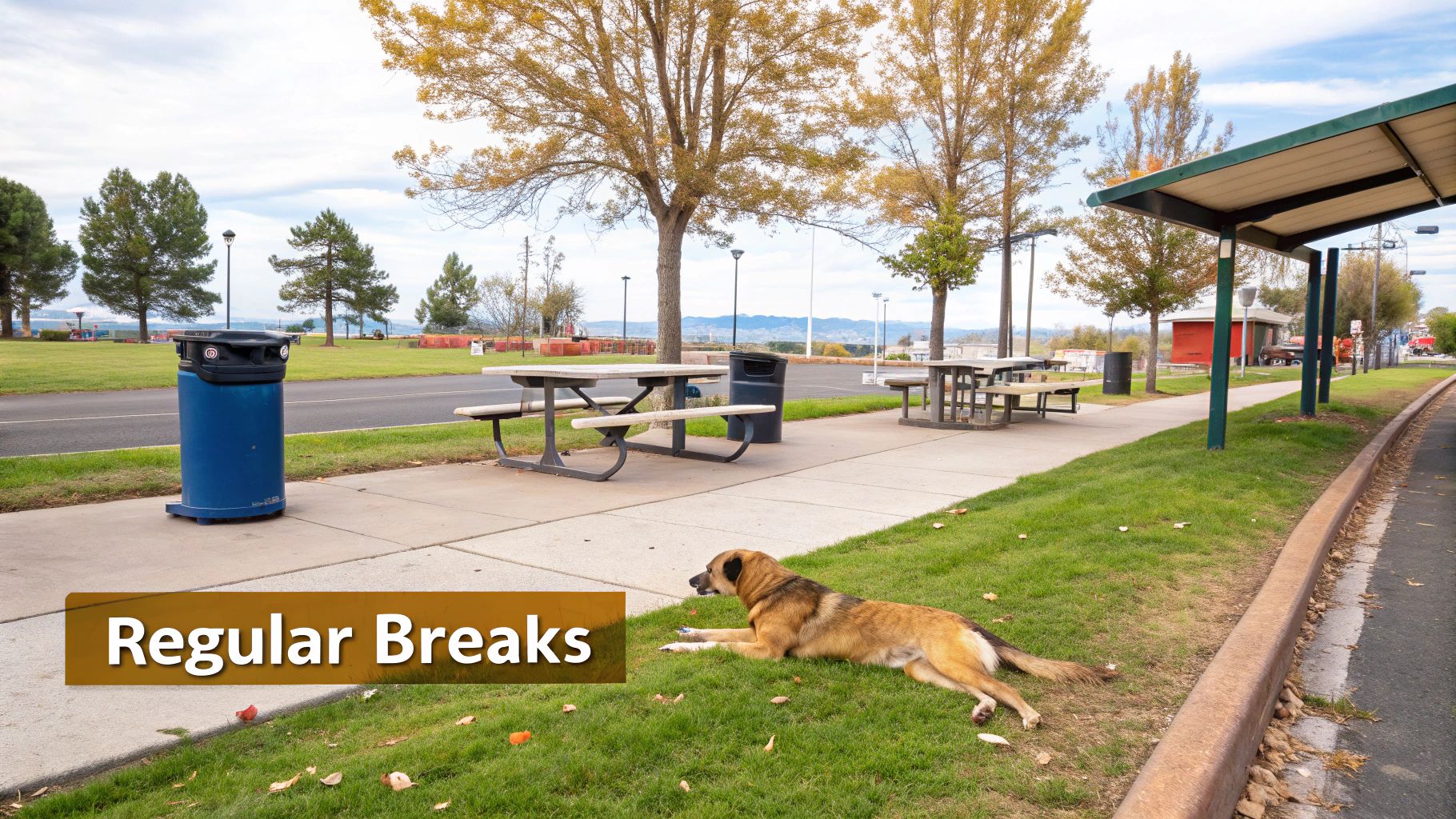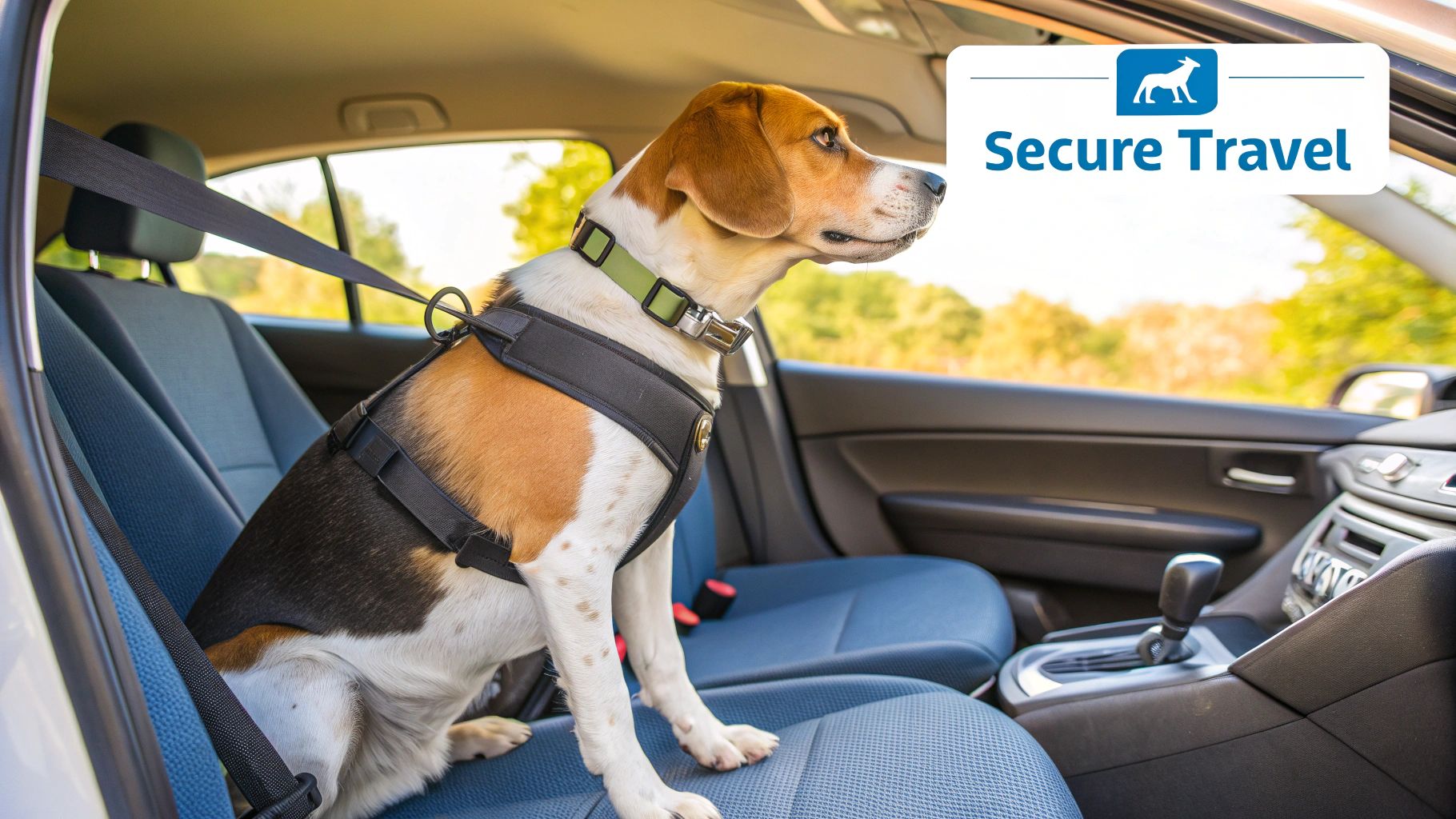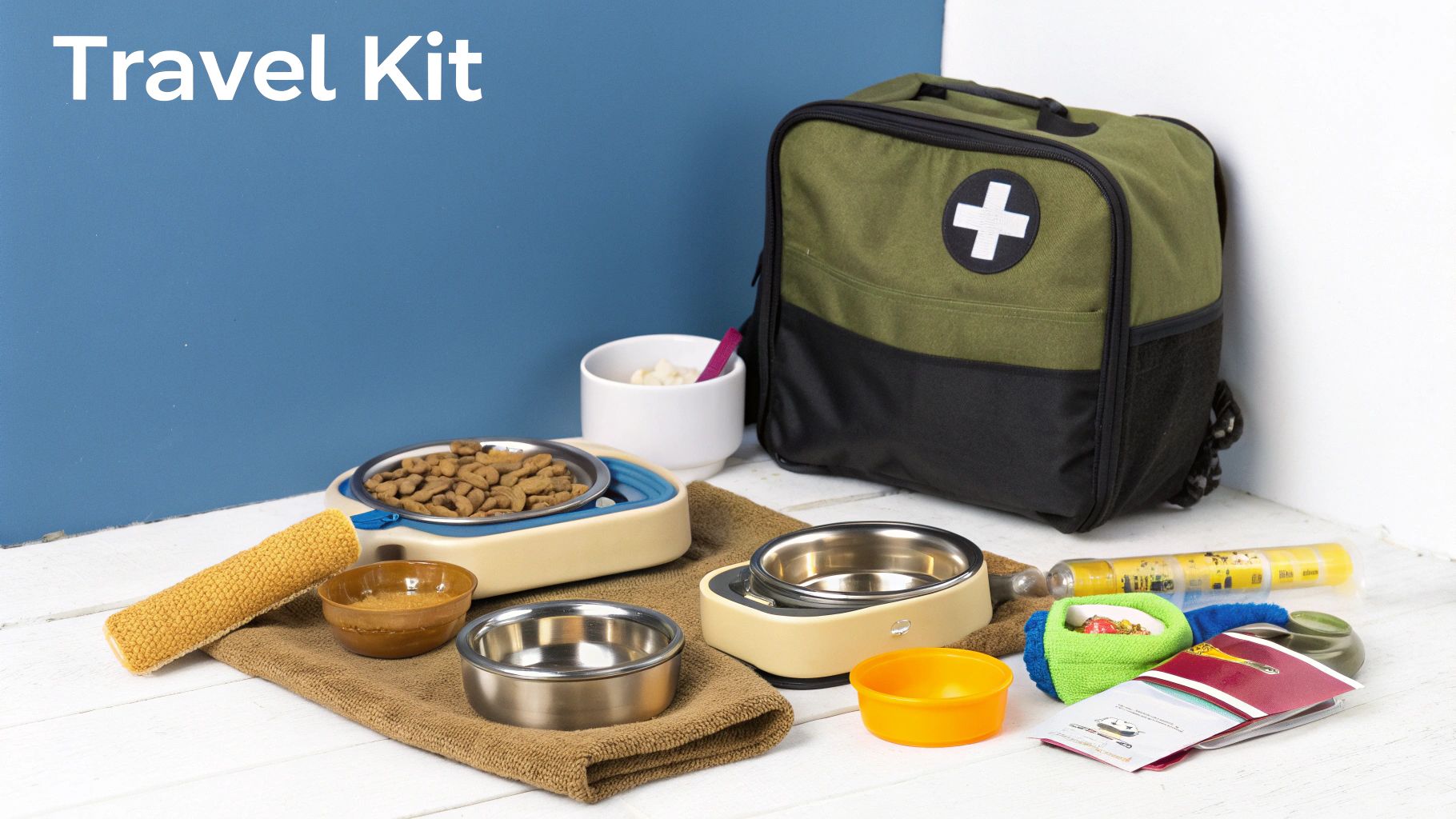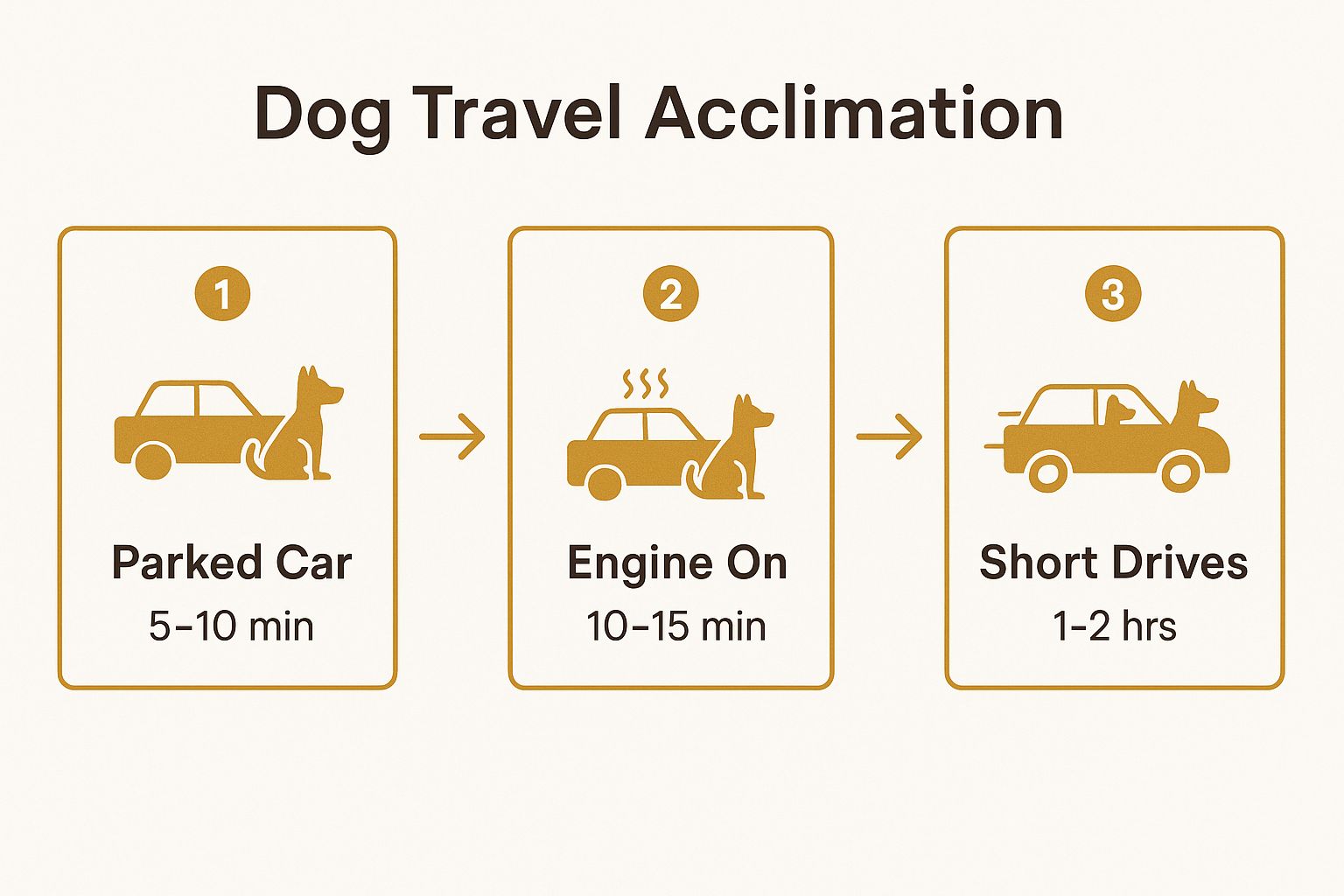The open road calls, and what's better than sharing that adventure with your loyal canine companion? A road trip with your dog can create unforgettable memories, but a successful journey requires more than just a full tank of gas and a good playlist. It demands thoughtful preparation to ensure your pet's safety, comfort, and happiness from start to finish. From essential safety gear to creating a calming environment in the backseat, a little planning transforms a potentially stressful ride into a joyful experience for everyone involved.
This comprehensive guide delivers seven actionable tips for road trips with dogs, packed with expert advice and practical steps to ensure a smooth adventure. We will cover crucial topics including how to properly secure your pet, what to pack in their travel kit, and the importance of planning for frequent, stimulating breaks. You'll learn how to acclimate an anxious traveler to the car and find genuinely dog-friendly accommodations, not just places that tolerate pets. Let’s get you and your furry co-pilot ready for the ultimate adventure ahead.
1. Plan Regular Stops Every 2-3 Hours
Just as humans need to stretch their legs on a long drive, so do our canine companions. Scheduling purposeful breaks every two to three hours is one of the most crucial tips for road trips with dogs, transforming a potentially stressful journey into a comfortable adventure. These stops are more than just potty breaks; they are essential opportunities for your dog to stretch, hydrate, sniff new smells, and mentally decompress from the confinement of the car.

Neglecting these breaks can lead to restlessness, anxiety, and even physical issues like stiffness or an increased risk of accidents inside the vehicle. A well-rested dog is a happier and safer travel partner, making the entire experience more enjoyable for everyone.
How to Implement Strategic Stops
Planning your route with your dog in mind is key. Instead of just stopping when you need gas, build breaks into your itinerary. Use your GPS or a route-planning app to identify potential stops ahead of time so you are not left scrambling for a safe spot.
Ideal locations for a dog-friendly break include:
- Highway Rest Areas: Most major interstates have designated pet relief areas, which are safely set back from traffic.
- Pet-Friendly Stores: Chains like Petco and PetSmart often welcome leashed dogs inside, providing a chance for a quick walk and a new environment to explore.
- Large Truck Stops: Many modern truck stops have grassy patches or dedicated dog parks, making them excellent choices for a longer break.
Actionable Tips for Productive Breaks
To make the most of each stop, be prepared. This simple habit elevates your road trip from a long haul to a series of mini-adventures.
- Pre-Plan with Apps: Use resources like BringFido or Google Maps (by searching for "dog parks near me") to locate ideal spots along your travel corridor.
- Safety First: Always keep your dog on a leash, even in designated off-leash areas, until you have assessed the environment for safety. Car doors should open into a secure area, not directly into a busy parking lot.
- Hydration is Key: Pack a portable water bowl and a jug of fresh water. Offer your dog a drink at every stop to prevent dehydration.
- Clean Up: Always carry waste bags and clean up after your pet immediately. This ensures these locations remain welcoming to other pet owners.
2. Secure Your Dog with Proper Safety Restraints
Just as you wouldn't drive without a seatbelt, your dog needs a dedicated safety system in the car. Proper safety restraints are one of the most vital tips for road trips with dogs, designed to protect them from injury during sudden stops or accidents. These systems, like crash-tested harnesses or carriers, distribute impact forces across the stronger parts of your dog's body, preventing them from becoming a projectile and minimizing driver distraction.

An unrestrained dog in a 30 mph crash can exert a force of hundreds or even thousands of pounds, posing a serious danger to both themselves and human passengers. Using a certified restraint system ensures your dog is secure, making the journey safer for everyone in the vehicle. This practice has been strongly advocated by organizations like the American Automobile Association (AAA) and the Center for Pet Safety (CPS).
How to Implement Proper Restraints
Choosing the right equipment is the first step. Not all products marketed for pet travel are created equal; it is essential to select one that has undergone rigorous, independent crash testing. Organizations like the Center for Pet Safety provide certification for products that meet high safety standards.
Top-rated, crash-tested restraint options include:
- Sleepypod Clickit Sport: This harness has passed rigorous crash tests and is known for its three-point design that secures the dog's entire torso.
- Kurgo Tru-Fit Smart Harness: A popular choice that offers dual functionality as both a walking harness and a car restraint, providing convenience and safety.
- ZuGoPet Rocketeer Pack: An innovative option that functions as a combined restraint and pet carrier, designed to minimize impact forces.
Actionable Tips for Using Safety Restraints
Proper implementation is just as important as the product itself. Follow these steps to ensure you are using the restraint correctly and effectively.
- Prioritize Certified Products: Only purchase harnesses or carriers that have been officially crash-tested and certified by an independent body like the Center for Pet Safety.
- Measure for a Perfect Fit: Before buying, accurately measure your dog’s chest and weight according to the manufacturer’s guidelines to ensure a snug, secure fit.
- Practice Before You Go: Let your dog wear the harness for short periods at home to get comfortable with it before your first trip.
- Avoid Collar Attachments: Never attach a car restraint to your dog's regular collar, as this can cause serious neck or throat injuries in an accident.
- Ensure Comfortable Positioning: Adjust the harness so your dog can sit up and lie down comfortably without getting tangled, but is still securely tethered.
3. Pack a Complete Travel Kit with Essentials
Having a dedicated, well-stocked travel kit is one of the most effective tips for road trips with dogs, ensuring you are prepared for any situation that arises. A comprehensive dog travel kit contains all the necessary supplies to keep your pet healthy, comfortable, and happy throughout the journey. This organized approach prevents you from forgetting critical items and helps you respond quickly to your dog's needs, from mealtime to unexpected messes.

Forgetting a crucial item like medication or sufficient food can turn a fun trip into a stressful scramble. A pre-packed kit removes that guesswork, allowing you to focus on the road and enjoy the adventure with your furry co-pilot. It’s the ultimate peace of mind packed into a single bag or container.
How to Assemble Your Dog's Go-Bag
You can purchase a ready-made bag or create a custom kit that perfectly suits your dog’s specific needs. The goal is to have everything organized and easily accessible, so you are not digging through your own luggage to find a leash or a water bowl. A well-organized kit streamlines every aspect of traveling with a pet.
Popular options for creating a travel kit include:
- Specialized Travel Bags: Brands like EliteField and Kurgo offer portable dog travel bags with designated compartments for food, toys, and supplies.
- DIY Storage Bins: Many pet owners create custom kits using clear plastic storage containers, which allows them to see contents at a glance.
- Dedicated Duffle Bags: A simple duffle bag or backpack designated solely for your dog’s gear works perfectly and keeps their items separate from yours.
Actionable Tips for a Well-Stocked Kit
To ensure your kit is truly comprehensive, think beyond just food and water. Consider comfort, safety, and health needs to cover all your bases while on the road. For more in-depth guidance, you can explore detailed checklists and advice. Learn more about travel tips for dogs on petvoyages.com.
- Overpack Food & Water: Pack at least 25% more food and water than you think you will need to account for travel delays or unexpected extensions.
- Bring Familiar Comforts: Include a favorite blanket, bed, or toy. The familiar scent will help reduce anxiety in a new environment.
- Include Important Documents: Pack copies of vaccination records, your vet’s contact information, and a recent photo of your dog in case they get lost.
- Prepare a First-Aid Kit: Your kit should include canine-safe antiseptic wipes, bandages, tick remover, and any prescribed medications.
- Pack for Cleanliness: Bring plenty of waste bags, paper towels, and a pet-safe cleaning spray for accidents.
4. Never Leave Your Dog Alone in the Car
One of the most critical safety rules for traveling with a canine companion is to never leave them unattended in a vehicle. This is one of the non-negotiable tips for road trips with dogs because it directly addresses life-threatening risks, including heatstroke, theft, and severe anxiety. Even on a seemingly mild day, the interior of a car can heat up to dangerous levels in just a few minutes, turning a quick errand into a potential tragedy.
This guideline is not just about responsible pet ownership; it is also a legal matter. Many states and municipalities have laws prohibiting this practice, with significant fines and even criminal charges for offenders. For example, states like California and Arizona have specific legislation that imposes penalties and even allows bystanders to take action to rescue a distressed animal. Adhering to this rule protects your dog’s well-being and ensures your trip remains trouble-free.
How to Implement a No-Solo-Dog Policy
Successfully following this rule requires proactive planning. Before you even start the car, your itinerary should be built around the understanding that your dog will be with a human at all times. This means choosing destinations, restaurants, and activities that welcome your furry friend.
Strategies for keeping your dog safe and accompanied include:
- Planning Around Pet-Friendly Venues: Intentionally seek out restaurants with dog-friendly patios, shops that allow leashed pets inside, and attractions that welcome four-legged visitors.
- Utilizing Drive-Throughs: For quick meals or coffee runs, drive-throughs are an excellent alternative to leaving your dog to go inside a building.
- Traveling with a Partner: If you are traveling with others, take turns. One person can stay with the dog while the other runs an errand, ensuring the dog is never left alone.
Actionable Tips for a Dog-Inclusive Journey
Integrating this rule into your travel habits is simple with the right tools and mindset. A little preparation goes a long way in creating a safe and seamless experience.
- Use Pet-Friendly Apps: Leverage resources like BringFido or pet-friendly filters on Google Maps and Yelp to identify restaurants, hotels, and stores where your dog is welcome.
- Confirm Policies in Advance: Always call ahead to confirm a location’s pet policy, as rules can change. This avoids any last-minute surprises or disappointments.
- Pack for Patio Dining: If you plan to eat at restaurants with outdoor seating, bring a portable water bowl and a chew toy or mat to keep your dog comfortable and occupied.
- Prioritize Pet-Friendly Lodging: Book hotels or rentals that explicitly allow pets. This ensures you have a safe place for your dog to stay if you need to attend a human-only activity.
5. Acclimate Your Dog to Car Travel Gradually
For many dogs, the car is associated only with trips to the vet, creating a foundation of anxiety. One of the most effective tips for road trips with dogs is to proactively change this association through gradual acclimation. This process involves a series of short, positive experiences in the car that slowly build your dog's confidence, turning the vehicle from a source of stress into a prelude to adventure.
Ignoring a dog's car-related anxiety can lead to significant issues on the road, including excessive drooling, whining, barking, and motion sickness. By systematically conditioning your dog to enjoy car travel, you are investing in a calmer, safer, and more enjoyable journey for everyone. This method is particularly crucial for rescue dogs or those with a history of travel-related phobias.
How to Implement Gradual Acclimation
The key to success is patience and positivity, starting at least four to six weeks before your planned trip. The goal is to progress at your dog’s pace, never forcing them into a situation that causes distress. Begin by simply encouraging your dog to sit in the parked car with you for a few minutes while offering high-value treats and praise.
A step-by-step approach for building car confidence:
- Parked Car Sessions: Start with the car off in the driveway. Let your dog explore the space, then reward them for calmly sitting in their designated spot. Keep these sessions short (5-10 minutes).
- Engine On: Once they are comfortable in a parked car, repeat the process with the engine running. This helps them get used to the sound and vibration without the added stress of movement.
- Short, Fun Trips: Begin with very short drives to a destination your dog loves, like a local park or a pet-friendly store. A five-minute trip ending in a walk or playtime reinforces that the car leads to good things.
Actionable Tips for Successful Conditioning
To make the acclimation process smooth and effective, focus on creating overwhelmingly positive associations. Every interaction with the vehicle should be a rewarding one.
- High-Value Rewards: Use special treats that your dog only gets during car training. This makes the experience feel novel and exciting.
- Praise Generously: Use an enthusiastic, happy tone of voice to praise your dog for calm behavior at every step.
- End on a High Note: Always end your training sessions before your dog becomes anxious or bored. This ensures they remember the experience positively.
- Consider Calming Aids: If anxiety persists, natural calming supplements or a compression vest can provide extra support. For more ideas, explore these soothing strategies for a dog anxious in car journeys.
The following infographic illustrates the progressive stages of this acclimation process, providing a clear visual guide for your training plan.

This step-by-step flow highlights the importance of starting slow and gradually increasing the duration and complexity of the car travel experience.
6. Research and Book Dog-Friendly Accommodations
Spontaneity can be part of the fun of a road trip, but assuming you can find a place to stay with your dog at the last minute is a recipe for disaster. Researching and booking dog-friendly accommodations in advance is one of the most essential tips for road trips with dogs. These pet-welcoming hotels, motels, and vacation rentals are designed to make overnight stays seamless, but they often have specific rules and limited availability.
Arriving at your destination after a long day of driving only to be turned away is stressful for both you and your pet. Securing your lodging ahead of time eliminates this anxiety, ensuring you have a confirmed, safe, and comfortable place to rest. A pre-booked, pet-approved room transforms your overnight stop from a point of stress into a welcome respite.
How to Implement Your Accommodation Strategy
Finding the right place requires more than just ticking a "pets allowed" filter. True dog-friendly properties go beyond mere tolerance and offer genuine hospitality. Start your search early, especially if traveling during peak season or to popular destinations, as pet-friendly rooms are often the first to be booked.
Ideal locations for a dog-friendly stay include:
- Hotel Chains: Many chains are known for their pet policies. Kimpton Hotels welcomes pets of any size with no extra fees, while La Quinta Inn & Suites typically allows up to two pets per room for free.
- Vacation Rentals: Platforms like Airbnb and Vrbo offer specific filters for pet-friendly properties, giving you more space and home-like amenities for longer stays.
- Campgrounds: KOA and other national campgrounds often have dedicated dog parks (KampK9s) and pet-friendly cabins, making them a great choice for outdoor-loving travelers.
Actionable Tips for Securing the Best Stay
To ensure a smooth check-in and a pleasant stay, a little extra diligence goes a long way. Confirming the details directly prevents unwelcome surprises.
- Book Well in Advance: Use dedicated resources like BringFido or GoPetFriendly to compare options, but always book as early as possible.
- Call to Confirm Policies: After booking online, call the hotel directly to confirm their pet policy. Ask about specific fees, weight or breed restrictions, and designated pet-friendly floors.
- Read Recent Pet Owner Reviews: Check reviews from other travelers with dogs to get a real-world perspective on the property’s pet-friendliness and any potential issues.
- Inquire About Amenities: Ask about designated potty areas, nearby parks, or any rules about leaving pets unattended in the room. You can discover more about preparing for a pet-friendly road trip on petvoyages.com to cover all your bases.
7. Prepare for Weather and Climate Changes
Driving across states or even counties can mean passing through multiple climates in a single day. Preparing for these shifts is a non-negotiable part of our tips for road trips with dogs, as our pets are far more sensitive to temperature extremes than we are. A dog left in a hot car can suffer from heatstroke in minutes, while cold weather can lead to hypothermia, making climate preparedness essential for their health and safety.
Failing to account for weather can turn a fun trip into a dangerous situation. Whether you are driving from a snowy mountain pass down to a sunny desert floor or through a sudden rainstorm, being equipped with the right gear ensures your dog remains comfortable and protected from the elements.
How to Implement Weather Preparedness
Proactive planning is the cornerstone of effective weather management. Before you even pack the car, you should check the detailed forecast not just for your destination, but for key points along your entire route. This allows you to pack a specific "climate kit" tailored to the conditions you will face.
Examples of weather-specific gear include:
- Hot Climates: For a summer trip through Arizona, pack a cooling vest, a portable fan that clips onto their crate, and protective booties for hot asphalt. Sun shades for the car windows are also critical.
- Cold Climates: A winter drive through the Rockies requires an insulated jacket, waterproof booties to protect from snow and de-icing salt, and perhaps a self-warming pet bed for overnight stays.
- Wet Climates: Traveling through the Pacific Northwest during the rainy season means bringing a waterproof coat, a highly absorbent towel for drying off after breaks, and a waterproof seat cover.
Actionable Tips for All-Weather Travel
Having the right gear is only half the battle; knowing how and when to use it is just as important. These habits will help you keep your dog safe no matter what the weather report says.
- Check the Route Forecast: Use a weather app that allows you to check conditions along a travel route, not just at a single destination.
- Pack a Climate-Control Kit: Depending on the season, bring a cooling mat or a portable heating pad that can be used in the car or at your lodging.
- Protect Their Paws: Paw protection is vital. Booties shield paws from scorching pavement in summer and from ice, salt, and chemical de-icers in winter.
- Monitor Your Dog Constantly: Watch for signs of distress. Excessive panting or drooling can indicate heat stress, while shivering and lethargy can signal your dog is too cold.
- Adapt Your Schedule: Be flexible. During a heatwave, plan your longest driving stretches for the cooler early morning or evening hours and keep outdoor breaks short. In extreme cold, make potty breaks quick and efficient.
7 Essential Road Trip Tips for Dogs Comparison
| Item | Implementation Complexity 🔄 | Resource Requirements ⚡ | Expected Outcomes 📊 | Ideal Use Cases 💡 | Key Advantages ⭐ |
|---|---|---|---|---|---|
| Plan Regular Stops Every 2-3 Hours | Moderate – requires planning and route research | Time investment for breaks; need for dog-friendly stops | Improved dog comfort, reduced anxiety, motion sickness prevention | Long road trips where dog's comfort and health is priority | Prevents accidents, reduces anxiety, maintains routine |
| Secure Your Dog with Proper Safety Restraints | Medium – requires selecting and fitting appropriate harness | Purchase of crash-tested harness; time to acclimate dog | Enhanced safety, injury reduction, decreased driver distraction | Any vehicle travel with risk of sudden stops or crashes | Significantly reduces injury risk, legal compliance |
| Pack a Complete Travel Kit with Essentials | Low to moderate – preparing and organizing supplies | Space and weight considerations; packing effort | Readiness for emergencies, stress reduction, maintained routine | Long trips or unfamiliar destinations | Ensures all needs met, prepares for emergencies |
| Never Leave Your Dog Alone in the Car | Low – behavioral rule enforcement | Requires planning for stops and accommodations | Avoids health risks and legal penalties | All travel situations where dog must not be left unattended | Prevents heatstroke/theft, complies with laws |
| Acclimate Your Dog to Car Travel Gradually | High – requires consistent time investment over weeks | Time and patience for gradual training | Reduced anxiety, prevention of motion sickness | Dogs new to travel or with previous travel anxiety | Builds confidence, makes travel enjoyable |
| Research and Book Dog-Friendly Accommodations | Moderate – requires advance research and booking | Possible higher costs, time to find suitable lodging | Comfortable stays, reduced stress for dog and owner | Multi-day trips, overnight stays | Ensures availability, provides pet-specific amenities |
| Prepare for Weather and Climate Changes | Moderate – requires weather monitoring and gear packing | Additional gear for various climates; route flexibility | Prevents weather-related health issues, maintains comfort | Routes with variable or extreme weather | Improves safety, allows year-round travel |
Your Next Great Adventure Awaits
Embarking on a cross-country adventure or a simple weekend getaway with your canine companion transforms a regular trip into a cherished memory. The journey itself, filled with new sights, sounds, and smells, becomes a shared experience that deepens the bond between you and your dog. We've explored the essential pillars for a successful canine road trip, from meticulous preparation to in-the-moment safety, ensuring every mile is as enjoyable as the destination.
The core of a successful journey lies in proactive planning. Mastering these tips for road trips with dogs means you're not just reacting to situations but anticipating them. You’re building a travel strategy centered around your dog's well-being, which is the ultimate goal.
Key Takeaways for the Open Road
Let’s distill our comprehensive guide into the most crucial takeaways. Think of these as your non-negotiable checklist before you turn the key in the ignition:
- Safety First, Always: Proper vehicle restraints are not optional. A well-fitted harness, secured crate, or car seat is the single most important piece of gear for preventing injury to both your dog and human passengers.
- Pacing is Everything: Your dog’s needs dictate the schedule. Regular stops every two to three hours for bathroom breaks, hydration, and a quick leg stretch are vital for their physical and mental comfort. Rushing leads to stress.
- Preparation Prevents Panic: A well-stocked travel kit, pre-booked pet-friendly accommodations, and a gradual acclimation to the car eliminate the most common sources of travel anxiety. Never underestimate the power of being prepared for the unexpected.
Turning Tips into Action
Knowledge is only powerful when applied. The true value of this guide comes from integrating these practices into your travel routine. Start small. If your dog is new to car travel, begin with short, positive trips around town before tackling a multi-hour drive. Before your next big trip, perform a "gear check" of your dog's travel kit, ensuring their food, water, medications, and records are packed and accessible.
By embracing these strategies, you shift from simply bringing your dog along to designing the entire experience around your shared adventure. You create an environment of security and fun that allows your dog's personality to shine, even in unfamiliar surroundings. This thoughtful approach is what separates a stressful ordeal from the road trip of a lifetime. The open road is calling, and with these expert tips for road trips with dogs, you and your furry co-pilot are more than ready to answer.
Ready to gear up for your next journey? Find all the veterinarian-approved safety restraints, travel-ready water bowls, and durable gear you need at Pet Voyages. We specialize in high-quality products designed to make traveling with your best friend safe, comfortable, and simple. Explore our curated road trip collection at Pet Voyages and travel with confidence.

